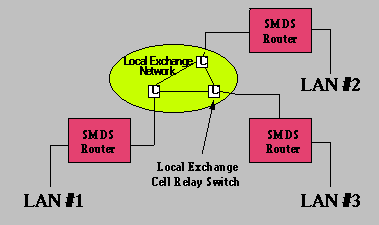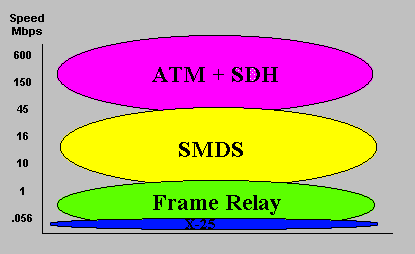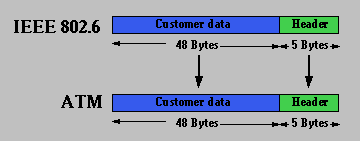Switched Multi-megabit Data Service (SMDS)
© Mercury Communications Ltd - January 1993
![]() 2007
network writings:
2007
network writings:
![]() My
TechnologyInside blog
My
TechnologyInside blog
The Switched Multi-Megabit Data Service, SMDS, is colloquially known as the first telephone service for computers and could be seen as a stepping stone to broadband-ISDN, B-ISDN. Riding on the back of the explosive growth in small computer local area network, LAN, installations, SMDS potentially offers users all the benefits of a public connectionless carrier service as an alternative to private systems. In effect, it provides the first tangible step to B-ISDN in a service that is being deployed now in the USA. That first step is for SMDS to focus on transparent LAN-to-LAN interconnection while ignoring voice traffic. It thus provides a potentially unique service that could be of real value to computer users.
SMDS is so new, and has moved ahead at such an unusually high speed, that it has really not achieved much publicity so far in Europe. This certainly seems to be an unusual, and rather undeserved oversight, bearing mind the potential impact and nature of this service.
The Origins of SMDS
Following the acceptance of the IEEE series of LAN specifications including, 802.3 Ethernet, 802.4 token bus, and 802.5 16Mbit/s token ring there was widespread growth of LAN installations in office and manufacturing environments. The capabilities of all these LAN standards are limited in distance and bit rate because they were originally designed to interconnect data-processing equipment within one building, or near buildings. Their physical span is limited to a few kilometres at rates up to 16Mbit/s. With the large installed base of LANs a new requirement came to the fore: the need to interconnect LANs, at high data rates over intra-city distances. This technology became known as a metropolitan area network or MAN. Two major standardisation programs addressed this need, fibre distributed data interface, FDDI, originated by Sperry; and distributed queue dual bus DQDB, formalised by IEEE in the 802.6 standard in 1987. The SMDS service is based on the IEEE 802.6 standard and only this will be discussed here.

Figure 1 - SMDS focuses on LAN-to-LAN Activities
DQDB
Due to parallel development, the IEEE MAN standard is compatible with the CCITT asynchronous transfer mode, ATM, standard for future cell relay services. In contrast to frame relay, 802.6 uses a fixed frame length structure called a cell. In fact, the cell consists of a 48-byte data payload with a 5-byte header. This approach enables the standard to support isochronous data for voice and video transfer, where delays on an individual packet must be held within a particular limit. As with frame relay, the cell relay approach of DQDB strips out error correction from layers 1 and 2 of the OSI model to dramatically improve data transfer rates - hence the use of the word relay.

Figure 2 - A DQDB Ring
With DQDB, the MAN is physically cabled with two fibre optic cables in a ring structure, one sending data clockwise, the other anti-clockwise. However, the ring is not complete and one node acts as a logical beginning, and end, of the bus. This approach provides two benefits.
Fault tolerance: If a failure occurs in the network, the end node in the network can transfer its role to the node next to the break and things carry on pretty much as normal.
Network efficiency: Because the network is not truly a ring, data packets do not need to travel the entire circumference of the ring to get removed from the ring as with a token-ring scheme.
The dual queue approach is the method of access control used with DQDB that optimises the network through the use of an ordered queue. This prevents an individual node from monopolising the network.
SMDS makes use of certain parts of the 802.6 standard, but as it relates to public networks, it does not utilise the dual-ring topology and queuing methodologies as encapsulated by DQDB.
SMDS
There are currently two public connectionless communication protocols defined. SMDS was the first and was originally defined by Bellcore and supported by ANSI was based on DQDB in the short term and ATM in the long term. The second is the connectionless broadband data service, CBDS, already finalised in Europe by ETSI (the ETSI MAN group is now disbanded). This again relies on DQDB in the near term and ATM in the longer term. Fortunately, SMDS and CBDS are compatible. In this report the term SMDS will be used as an umbrella term to encompass both SMDS and CBDS.
Rather than thinking of SMDS as a LAN-to-LAN service, it would be better to consider it as the first true node-to-node (or PC-to-PC) service via a public network. Unlike frame relay data is delivered to an individual user on a remote network transparently. This is the ultimate goal of cell relay based ATM or B-ISDN services for both computer and multi-media data. SMDS can be clearly positioned by considering its unique selling points:
- High speed
- Connectionless, broadcast communication
- Cell relay
- Fast packet
- Public data-networking service
Let us look at each of these characteristics in turn:
High Speed
SMDS is initially aimed at supporting the needs of bursty data sources. These are data sources that generate data at high data rates for short periods of time, but leave large gaps between these pulses of frenetic activity. This traffic is typical of what is encountered when linking computers together, but is altogether unlike what is encountered in voice or video applications where a steady stream of data, albeit at varying rates, is encountered.

Figure 3 - The Relationship Between Services
SMDS will initially provide access rates between the E1 bearer rate of 2Mbit/s and E3 at 34Mbit/s, (in the USA rates are 1.5, 4, 10, 16 and 34Mbit/s on a 45Mbits/s access line. These intermediate rates match common LAN data rates). Thus it is positioned, from an access rate point of view, above frame relay. SMDS is fully compatible with synchronous digital hierarchy, SDH, and Bellcore / CCITT will be issuing specifications to support higher SONET and SDH (STM-1, 155Mbit/s) rates within 18 months.
When a local PC or workstation wants to send data to a remote machine, the LAN creates data packets and forwards these to the SMDS compatible router. The router, which is equipped with an SMDS interface card, converts the variable length frames generated by the LAN into fixed length SMDS cells, which are then sent to the local public exchange via an E1 or E3 bearer link . On receipt, the destination SMDS router converts the cells back into the LAN packet format and forwards them to the destination PC of workstation.
Connectionless, Broadcast Communication
SMDS has evolved out of switching and transmission standards of LANs and has adapted to the public network domain. Just as a LAN bus is shared by multiple users, the trunk links operated by PTOs will carry traffic from different customers. This shared bandwidth is key to the economics of SMDS. SMDS is a connectionlesstransmission scheme where there is no traditional call set-up/tear-down process such as encountered with X.25. Like the LAN on customer's premises, every SMDS cell contains the FULL address of the destination in the header. Local exchange cell relay switches route each packet to the destination LAN and then onto the destination machine.

Figure 4 - ATM and SMDS Cell Structure
There are two types of SMDS message: The first is a message addressed to a single recipient. These cells make their way via any path through the network to the destination address. The second is a message addressed to multiple recipients, in effect a broadcast (multicast in SMDS terminology). Here, each cell is sent to customers having a suitable multicast address. Hence, it is possible for a company to send a message to all its employees, no matter what their location. As SMDS operates over public networks, each company has its own unique multicast address. If they didn't, all users would receive the message even if they didn't work for that company!
Cell Relay
SMDS has been designed to have a cell relay architecture to ensure compatibility with future ATM / SDH broadband services. Principle compatibility has been ensured by matching the IEEE 802.6 cell as used by SMDS to the ATM cell. Both cells have a 48-byte data payload combined with a 5-byte header as shown in Figure 4.
Without going into too much detail, the 802.6 specification describes an activity called segmentation. The segmentation process takes raw packets of data (in say TCP/IP, Appletalk or DECnet format) arriving from the LAN and, encapsulates them into an intermediate format with appropriate control data. This includes the full destination address and access control information. These are broken down into 53-byte cells ready for transmission. These cells are then sent to the destination SMDS router, where the reverse reconstruction process takes place. Each SMDS cell knows where it is going within the SMDS network and once the LAN data frame is reconstituted, it knows the final destination address as well. This explains how a connectionless service can be operated by a connection oriented service such as ATM. It should be remembered that this connectionless facility comes at a heavy cost by reducing the available bandwidth by as much as 25%. The 802.6 standard provides for both connection-oriented transmission, where each cell is transmitted via a predefined path, and isochronous transmission, a type of connection oriented transmission in which cell delivery is guaranteed within a defined time. The 802.6 committee are expected to have a complete isochronous specification for SMDS within 18 months. SMDS specifies a 64-bit address which is sufficient to address a billion different destinations. In contrast, as frame relay is connection oriented, its address field is only 10 bits long allowing for only about 1000 different addresses. SMDS addresses follow the structure of the 15-digit CCITT E.164 numbering plan. Any SMDS customer can communicate with any other SMDS customer by simply using the appropriate address. This is an important service feature as it allows for inter-enterprise networking among all subscribers to the service. Although most data traffic is currently sent within an organisation, as the need for data connectivity between companies spreads, SMDS will provide this service.
Fast Packet
As discussed extensively in the TW dedicated to frame relay, SMDS also strips out error correction from level 2 of the OSI model to improve transmission rates. It can thus be classed as a cell relay as well as a fast packet service (frame relay is not a cell relay service) with currently defined access rates between E1 - 2.048Mbit/s, and E3 - 34Mbit/s. Being ATM compatible, it is also upwards compatible with SDH.
The total overhead needed to support a connectionless service is quite considerable. About 24% of the usable bandwidth is consumed by the SMDS headers and trailers. This cuts down the available bandwidth on an E1 2.048Mbit/s line to around 1.6Mbit/s on a real network. This is the price currently paid for a connectionless service.
Public Data-Networking Service
Although IEEE 802.6 describes the segmentation and reassembly of LAN frames to be carried over the network in ATM compatible cells, it does little to describe a service like today's telephone service where you can pick up a telephone and be connected to almost anyone. Bellcore has combined the 802.6 specification with a series of SMDS technical requirements to fill in the gaps. Bellcore documents, unlike 802.6, describe how to manage SMDS networks, how to create billing information for the service, and how to administer the service. Also, as SMDS operates in the public arena it provides both source and destination address screening against allowed or disallowed addresses as provided by the customer. Packets that fail such tests are discarded. A customer can decide whether to have a particular SMDS address freely available or restricted in access.
On performance, Bellcore specifies that the end-to-end delivery time within a city of a reasonable size , using an SMDS packet of 9188 bytes with E3 access at both ends, is 20mS or less in 95% of cases. In practice, an average packet would be subjected to delays of less than 10mS. This should make the presence of an SMDS network relatively transparent to the user, which is a key requirement.
SMDS in Balance
Although the LAN community has been crying out for the facilities offered by a service such as SMDS, there are a plethora of issues that could, and will, affect its success. Functionally, SMDS delivers the same result as linking independent LANs by private lines. There are three important differences though: The first is: The possibility of reduced private line costs. Private line tariffs are based on end-to-end distances. If a customer has only two locations to be linked, it is likely that a dedicated line would be the most cost effective solution. However, when more than two locations are involved, SMDS could come into its own. This very much depends on how the proposed tarriffing structure (in the US anyhow) pans out. At the moment it is based on connection time and connection bandwidth. Secondly, there is access to a wide range of end-points. Private lines are connected to a fixed number of end-points. In contrast, an SMDS user can send data to any other user on the public network. Finally, service providers can offer enhanced services. For example, if a destination router doesn't respond, the network could store the file until the router is back on line, or it could be diverted to any other nominated user.
Roundup
SMDS is the first tentative step to providing users with some of the real benefits of a diallable broadband service. Although it is still early days, it would seem that the 'chicken and egg' syndrome may be avoided in the USA by the wide scale support of the regional Bell operators. Extensive trialling has taken place in the 91/92 time frames with 'roll out' taking place from Q3 1992 through 1993, although many issues still need to be resolved.
SMDS does represent a bold step forward. The unknown at this time is whether SMDS will make best use of its window of opportunity before ATM becomes available. There is also the interesting question of whether SMDS will be considered an irrelevant overhead that will not be required when ATM finally arrives. This is because LANs could, and probably will, utilise ATM directly and, with updated protocols, could communicate direct in a connectionless fashion without the need for SMDS at all. As product acceptance always takes far longer than anyone predicts, this particular scenario may not be so far away from what actually happens
